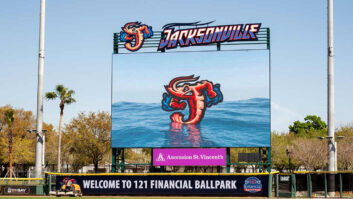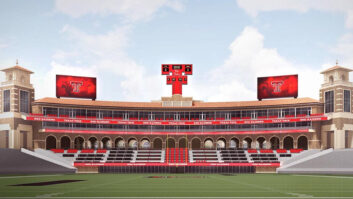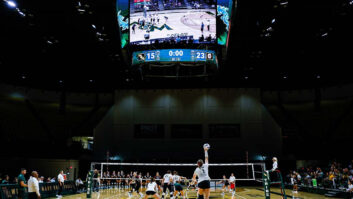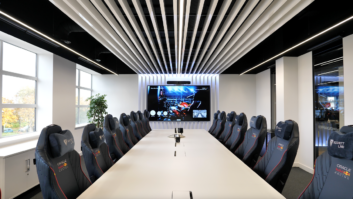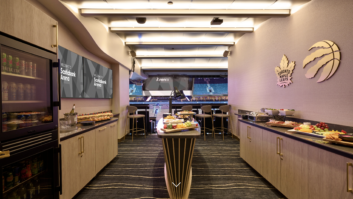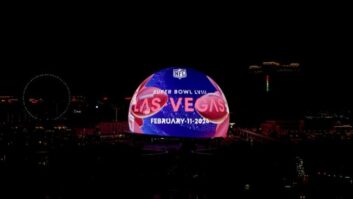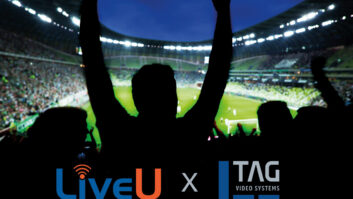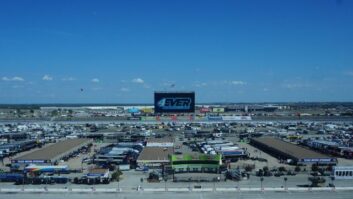Within seconds of Spain’s victory at the Euro 2008 football championship last month, the world’s sports media had risen as one to describe it as “a victory for beautiful football”. But now that the celebrations are over and the breathtaking skill of Torres, Fabregas, David Villa and company have become a more distant memory, Europe’s systems integration community must sit down and ask itself: was the tournament a victory for us, too?
Certainly, there will have been a greater variety of audio, video and systems technology used at the eight Euro 2008 venues in Austria and Switzerland than at any comparable event in recent years. The question is: was it sold and serviced at a price that made the whole competition worthwhile for AV suppliers? And, perhaps more pertinently, will there be longer-term benefits for the relationship between systems integrators and customers in the sports sector?
Of all the markets that our industry serves, few are as fickle, as unpredictable, and as driven by largescale, one-off events as sports. Sure, there will always be the bread-and-butter renewal of things such as PA/VA systems in sports arenas, both indoor and outdoor. But as for the rest – the supply of technologies such as large video screens and high-level sound-reinforcement systems, for example – the market remains dominated by rental.
Headquartered in London with offices in Belgium, the US, Hong Kong and Shenzhen (China), DisplayLED specialises in sourcing LED video technology for a variety of end customers, with the sports industry being a key focus. The company’s Graham Burgess says DisplayLED offers a service at every stage of screen supply – from consultancy and procurement through to installation, maintenance and the provision of content.
“We have our own products which we market under the DigiLED brand, and we work with all the leading manufacturers of complete screen solutions,” Burgess explains. “So, depending on a stadium’s budget, we can supply a system that meets the customer’s needs.”
New uses
The traditional applications for LED video technology in stadia are for giant screens that show (among other things) instant replays of key moments in a game, and for perimeter boards, which act as a vehicle for digital advertising content. However, recent DigiLED successes have included projects in which LED screens have effectively been used to provide a more dynamic and customisable alternative to the traditional scoreboard. This has been the case at venues such as the Galpharm Stadium in Huddersfield, Hull’s KC Stadium and Glasgow’s iconic Hampden Park.
“Hampden was a particularly nice job,” Burgess recalls. “We replaced the old BT-sponsored scoreboards with a 53sq m D12 screen at each end of the ground, above the east and west stands, and in time for Scotland’s European Championship qualifier against Italy.” Despite getting a good reference from Hampden, however, the company then failed in bids to win similar business from Glasgow’s two major football clubs, Celtic and Rangers, who Burgess says “bought completely on price”.
Cost is always going to be an issue on any project, but Burgess believes that only at the very top level of football – and sport in general – is there enough money from TV rights deals and sponsor revenue for leading-edge AV technology to be justified. “Celtic and Rangers are in the Scottish Premier League and expected to generate only about £750,000 per year from their screens,” he says. “At that level it’s marginal whether they’re going to be making money from their investment. On the other hand, at their new Emirates Stadium, Arsenal FC have seen their income from perimeter advertising quadruple since we supplied them with an LED system; within a year they’ve recouped an investment that you would normally amortise over five years.”
According to Burgess, it is the sheer audience muscle of Premier League football that gives clubs such as Arsenal the opportunity to make such a rapid return on their investment in AV technology. “Unless you have huge TV viewing figures, digital perimeter boards aren’t going to generate money as quickly as some people think,” he says.
That may change as the cost of LED technology comes down, of course. And, in the meantime, it is worth taking a step back to admire just what has been achieved at the Emirates Stadium, less than two years since it opened. In addition to the digital perimeter advertising, DisplayLED has supplied two Mitsubishi DiamondVision LED screens, each measuring 12m wide by 6m high and installed at diagonally opposing corners of the ground. They are used to show a variety of content, from pre-match team news and announcements to advertising and action replays. There are even two digital LED clocks, sponsored by Swiss watchmaker Ebel, embedded as permanent items within the perimeter displays at the halfway line.
In the zone
When it comes to TV audiences, few sporting events come bigger than the European Championship just held in Austria and Switzerland. This explains why all eight stadia were fitted with LED displays of some kind before the competition kicked off. It would be a mistake, though, to view the AV opportunity presented by such a tournament as being confined to the stadia themselves.
The past decade has witnessed the inexorable rise of what has become known as the ‘fan zone’ – an open area in which supporters can watch games live on large LED screens. These zones were originally devised as a means of occupying the thousands of fans who would travel to major tournaments without tickets, and whose presence in host cities might otherwise have nuisance value (at the very least) once their quest for tickets had ended in failure. Since then, however, the concept has been rolled out beyond the borders of host nations to countries whose teams are merely taking part in a tournament – effectively giving stay-at-home supporters a flavour of the event, without the cost and hassle of actually travelling.
“Fan zones were huge for us during Euro 2008,” comments Burgess. “We built five trailers for Massteknik, which were used in Switzerland and to relay games around Sweden and Germany, two screens for Supervision of France for use in Basel, and four for Atman of Croatia, which installed them at stadia in Lausanne, Biel, Aarau and St Gallen – Swiss cities that weren’t hosting matches themselves. In total we had around 1,000sq m of LED out during the tournament.”
If ever a market cried out for its suppliers to be savvy at both installation and rental, it’s sports. Sweden’s Massteknik is a prime example.
Based in Kungälv, about 20km outside Gothenburg, the company is perhaps best-known for the provision of large LED screens and video trailers, but equally offers a wide range of other services, including AV systems integration, technical project management, IT network support and creative consulting. Sporting events are a key part of Massteknik’s activities, and last year’s merger with OB specialist Prisma and lighting-and-sound company Primetec, which brought about the formation of the MediaTec Group, has further broadened the offering.
“These are exciting times for us,” says MediaTec Group CEO Kenneth Paterson, who is based in Kungälv. “In addition to all Massteknik’s rental activities for Euro 2008, we also have three Prisma OB trucks making their way to China for the Beijing Olympics, including HD-1, our new, state-ofthe- art HD truck, which folds out from both sides to provide two separate production rooms, a true 5.1 surround mixing area and 34 operator seats – in total, around 75sq m of operating space.”
Going forward, Paterson sees the synergies between the three members of the MediaTec Group as having particular appeal to customers in the sports industry. After all, if you can get your large-screen displays, your lighting, staging and sound, and your broadcast facilities from a single provider, why use three different companies? For the time being, though, he is just as happy to discuss the immediate future, and the ability of his people and their technology to serve more modest needs in a way that still makes business sense.
As an example, Paterson cites Massteknik’s long-standing relationship with the top division of Swedish football – not exactly the wealthiest or most glamorous in Europe, but a worthwhile business partner nonetheless. “We’ve been working with the league since 2001, supplying many matches with mobile screens because the clubs themselves don’t have the budget to justify a fixed screen,” he says. “This year the league is adding two teams to make a total of 16, giving us 240 games during the season where we will have a mobile screen on site.”
Small wonder, then, that Massteknik has invested in five new video trailers this year. “Our fleet now totals 21 trailers,” continues Paterson, “with screen sizes measuring from 15 to 88sq m. The smaller screens come with their own production studio inside the trailer, and can be driven, erected and run by a single member of our team – which reduces the cost for the end customer and makes the technology viable, even for smaller clubs.”
Bespoke systems
While the likes of IFK Norrköping and Djurgårdens IF (to name but two members of the Swedish top flight) may be content with AV content that is relatively standardised, the bigger a sporting brand is, the more likely it is to require a custom solution to its multimedia needs. Arsenal’s Emirates Stadium even includes its own HD broadcast facility for the creation of custom video content that is distributed not only across the facility, but nationally and internationally through cable TV and the internet. And if the end customer needs a custom solution, you can bet that their sponsors do, too.
This is where bespoke image processing and software capabilities come into their own. Ipswich-based Technographic Displays has been providing custom display control solutions for the sports industry, among other sectors, since it was formed 10 years ago – though MD Arthur Jackson’s involvement in the LED business goes back nearly another decade to the design and installation of some of the first outdoor LED screens in the UK.
“We do still manufacture some non-standard LED displays for customers,” Jackson says, “but our main focus now is the integration of video wall technology with scoring, action video and advertising. Our software controls both the image processors and the display wall controllers. Click a button, and all the right commands go to the various bits of kit in the system. We use standard pieces of software that we customise for each job.”
Technographic offers two levels of sports industry solution. The sim- pler of the two, TechScore, is being used at Dutch football club SC Heerenveen, Grenoble Foot 38 in France (see case study, page 36), and in a version suitable for rugby at Twickenham in London. A more sophisticated offering, TechEvent, was developed with AV rental company CT to serve the athletics market. It has since been customised to integrate with third-party cricket scoring software at Trent Bridge in the UK, home of Nottinghamshire County Cricket Club.
Jackson is rightly proud of the Trent Bridge project, in which an 83sq m Mitsubishi ODQ10 DiamondVision screen has been installed in portrait mode on the façade of an office building that faces the cricket field. During nontelevised matches, the wall acts as a full-screen scoreboard. When the cameras are in, the portrait format enables a 56sq m, 4:3 aspect ratio video picture to be displayed above a 27sq m abbreviated scoreboard driven by TechEvent.
“Our goal is to ensure that when we’re finished with a project, the inhouse team at a stadium can operate the screen in a completely self-contained way,” Jackson says. “At Trent Bridge, Notts specified exactly the content they wanted, and their marketing department generated a lot of the graphics themselves. We’re very pleased with the results. It’s the newest screen in cricket, and even [controversial commentator] Geoff Boycott has praised it on air!”
Enabling development
What particularly pleases Jackson is the way the office development’s architect has integrated the screen into the building and its environs, so that it looks as though “the AV is part of the ground, not something that has been added as an afterthought”. Even the largest of sports industry customers often depend on what is known as ‘enabling development’ to realise stadium new-build or refurbishment projects. In the case of Stadium MK in Milton Keynes (see Solutions story, page 38), this meant acquiring land from a variety of freeholders, then selling it to big retail chains such as Ikea and Asda. Other arenas have retail or leisure developments built into their architecture. For example, Berne’s new Stade de Suisse, which hosted three games during Euro 2008, has a complete shopping and catering mall located under its playing surface.
Having a bigger site to play with gives contractors the chance to extend their systems facility-wide. In Berne, for instance, Swiss distributor and integrator Dr W A Günther was able to extend its Harman Pro HiQNet-based network beyond the stadium into other areas of the development, such as conferencing, retail and so forth.
Yet the larger and more prestigious a sports project becomes, the tougher it can be to maintain margins. As Michael MacDonald, Harman Pro’s executive VP of marketing and sales, puts it: “Big stadium projects can be worth a lot of money on paper but, as a supplier, you are often under pressure to lose some of your margin – perhaps even all of it – on local advertising opportunities, the use of VIP boxes, and so on. Building owners are getting really sophisticated about working the value chain, and it’s becoming a real strain on how we do business.”
And what of the future? Most commentators agree that the wind is blowing towards more and more fixed AV in sports venues, albeit slowly. Jackson says that in cricket, for example, “the ECB [England & Wales Cricket Board] has put out a directive that all grounds wanting to host Test Matches from 2009 onwards have to have a permanent replay screen of their own, rather than renting. That’s because the ECB has commercial deals with its sponsors and want to be able to offer replay sponsorship as part of the package. That’s good for us, because we can mix sponsor content with pure scoring content.”
Burgess concurs, citing horse-racing as another example of install growth. “That market used to be almost all rental,” he says, “but now you’ve got courses such as Lingfield, Ripon and Ascot all with their own screens, then renting supplementary ones for their biggest races.” If the trend continues, it will encourage architects and designers to allow for AV from the start – a move most integrators would welcome. Today, even the Emirates Stadium, for all its state-of-the-art technology, still suffers from restricted sightlines to its LED screens from some sections of seating. Perhaps only when we can all see – and hear – clearly at every event will our industry really have given AV technology the sporting chance it deserves.
